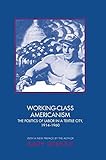Working-Class Americanism : The Politics of Labor in a Textile City, 1914-1960 / Gary Gerstle.
Material type: TextPublisher: Princeton, NJ : Princeton University Press, [2022]Copyright date: ©2002Description: 1 online resource (373 p.)Content type:
TextPublisher: Princeton, NJ : Princeton University Press, [2022]Copyright date: ©2002Description: 1 online resource (373 p.)Content type: - 9780691228235
- Textile industry -- Rhode Island -- Woonsocket -- History -- 20th century
- Textile workers -- Rhode Island -- Woonsocket -- History -- 20th century
- HISTORY / United States / 20th Century
- Alsace spinning mill
- Amalgamated Clothing Workers
- American Legion
- Americanization campaigns
- Armenian workers
- Blackstone Cotton local
- Bonin Spinning mill
- Bouvier, Joseph
- Canzano, Victor
- Cardijn, Cardinal
- Catholic Church
- Christian Family Movement
- Courtemanche, Jude
- Daignault, Elphège
- Desurmont spinning mill
- Divini Redemptoris
- English immigrants
- Falls Yarn mill
- Franco-American identity
- French Worsted mill
- Goval, Charles
- Guerin Mills-Rosemont
- Howe, Irving
- ITU radicals
- Independent Club
- Industrial pluralism
- Jews
- Joyland Ballroom
- Keynesianism
- Lawton Spinning
- National War Labor Board
- Peck Law
- Pilgrims
- Portuguese workers
- Providence Journal
- Quebec
- anticommunism
- arbitration
- benefits
- corporatism, Catholic
- dues collection
- ethnic corporatists
- ethnic lodges
- ideological independence
- job security
- kinship networks
- liberalism
- management prerogatives
- millowners
- mulespinners
- nativism
- open-books campaign
- 331.76770097452 23
- HD8039.T42
- HD8039.T42
- online - DeGruyter
| Item type | Current library | Call number | URL | Status | Notes | Barcode | |
|---|---|---|---|---|---|---|---|
 eBook
eBook
|
Biblioteca "Angelicum" Pont. Univ. S.Tommaso d'Aquino Nuvola online | online - DeGruyter (Browse shelf(Opens below)) | Online access | Not for loan (Accesso limitato) | Accesso per gli utenti autorizzati / Access for authorized users | (dgr)9780691228235 |
Browsing Biblioteca "Angelicum" Pont. Univ. S.Tommaso d'Aquino shelves, Shelving location: Nuvola online Close shelf browser (Hides shelf browser)

|

|

|

|

|

|

|
||
| online - DeGruyter A Phoenix in the Ashes : The Rise and Fall of the Koch Coalition in New York City Politics / | online - DeGruyter The Princeton Handbook of Multicultural Poetries / | online - DeGruyter Working-Class Formation : Ninteenth-Century Patterns in Western Europe and the United States / | online - DeGruyter Working-Class Americanism : The Politics of Labor in a Textile City, 1914-1960 / | online - DeGruyter Obligations of Citizenship and Demands of Faith : Religious Accommodation in Pluralist Democracies / | online - DeGruyter The Other God that Failed : Hans Freyer and the Deradicalization of German Conservatism / | online - DeGruyter Elizabeth I : War and Politics, 1588-1603 / |
Frontmatter -- Contents -- Illustrations and tables -- Preface to the Princeton edition -- Acknowledgments -- Introduction -- Part I. Ethnictown, 1875-1929 -- 1 The French Canadians -- 2 The Franco-Belgians -- Part II The emergence of an industrial union, 1929-1936 -- 3 Beginnings, 1929-1934 -- 4 City wide mobilization, 1934-1936 -- Part III Working-class heyday, 1936-1941 -- 5 "A new, progressive Americanism" -- 6 Ethnic-style unionism -- 7 Ethnic renaissance -- Part IV The crucial decade - and after, 1941-1960 -- 8 The struggle for union power, 1941-1946 -- 9 "Be American!": refashioning a political language, 1944-1946 -- 10 The failure of two dreams, 1946-1960 -- Conclusion -- Appendix A: Locals organized by ITU, 1932-1955 -- Appendix B: A note on union sources and a list of interviewees -- Index
restricted access online access with authorization star
http://purl.org/coar/access_right/c_16ec
In this classic interpretation of the 1930s rise of industrial unionism, Gary Gerstle challenges the popular historical notion that American workers' embrace of "Americanism" and other patriotic sentiments in the post-World War I years indicated their fundamental political conservatism. He argues that Americanism was a complex, even contradictory, language of nationalism that lent itself to a wide variety of ideological constructions in the years between World War I and the onset of the Cold War. Using the rich and textured material left behind by New England's most powerful textile union--the Independent Textile Union of Woonsocket, Rhode Island--Gerstle uncovers for the first time a more varied and more radical working-class discourse.
Mode of access: Internet via World Wide Web.
In English.
Description based on online resource; title from PDF title page (publisher's Web site, viewed 29. Jun 2022)


